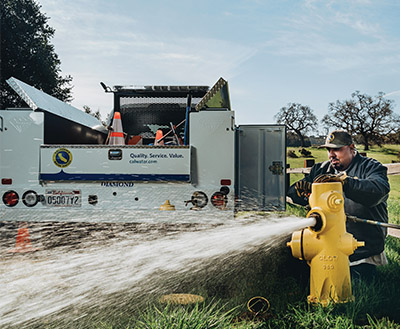Water Quality
Why does Cal Water sometimes flush water from pipes?

At Cal Water, we conduct periodic flushing as part of our ongoing water quality and water system maintenance program. By opening certain fire hydrants under controlled conditions, we remove minerals and sediment that build up in water lines over time. This improves water quality and increases the amount of water that can flow through the water lines.
Although it may seem wasteful to the casual observer, flushing is actually an important and necessary water utility activity that is endorsed by the American Water Works Association and conducted in accordance with guidelines set by the California Division of Drinking Water.
You will continue to receive water while we are flushing, but the pressure might be lowered temporarily. If you notice any discoloration and/or sediment in your water after we have flushed, please allow water to run from your outside hose bib until it clears.
What causes hard water?
Water is considered soft if total hardness is less than 75 ppm, moderately hard at 75 to 150 ppm, hard at 150 to 300 ppm, and very hard at 300 ppm or higher. To convert the hardness of your water from parts per million to grains per gallon, simply divide by 17.1
Water’s hardness varies with its source. Hard water is not harmful to health, so the choice to buy a water softener is an aesthetic one. However, people on low-sodium diets should be aware that many water softeners increase the sodium content of the water. The hardness of your water is listed in your annual water quality report.
What are trihalomethanes?
Trihalomethanes (chloroform, bromoform, bromodichloromethane, and chlorodibromomethane) are commonly found in drinking water that has been chlorinated or chloraminated. Trihalomethanes (THMs) form when chlorine reacts with organic matter in the water. THMs are found mainly in water that originally came from surface sources, such as rivers and lakes. THM levels are typically low in groundwater (produced by wells). THMs have been associated with increased cancer risk, at least in animals, and the EPA has for many years regulated the amount of THMs allowable in drinking water.
Why is drinking water chlorinated/chloraminated?
Drinking water is often chlorinated or chloraminated to kill microorganisms that could cause serious illnesses. Overall, chlorination of drinking water has benefited public health enormously.
There are other methods of disinfecting public drinking water, but they are often more expensive, and the potential health effects of using these other methods are generally less well understood. Additionally, some alternative disinfectants do not remain effective as the water is transported from the source to the tap through the distribution system.
Is there a regulatory standard for chlorine or chloramine in water?
Drinking water utilities that use chlorination or chloramination are required by law to sample water throughout their distribution system, average the total THM measurements, and report the results to the Division of Drinking Water. The Maximum Contaminant Level (MCL) permissible for total THMs in drinking water by California and federal law is currently an average of 80 parts per billion (ppb) over four consecutive quarters. In other words, a utility has not violated the standard unless the average system-wide level over the past year is more than 80 ppb. There are no standards currently for the individual trihalomethanes.
What are the California Division of Drinking Water and EPA doing to look at the issue of THMs in drinking water?
In 2006, the MCL for THMs and HAAs was revised so that the MCL was met at every location, and not just in the system as a whole.

